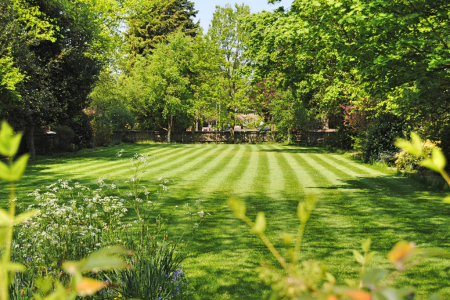Aesthetics is a set of principles concerned with the nature and appreciation of beauty. Grass aesthetics include aspects like the way the lawn feels underfoot and its park-like appearance. Or maybe the lawn is filled with white clover and violets, which support pollinating insects without looking weedy. Perhaps the aesthetic is a bit rougher underfoot and able to withstand children playing, backyard sports, and swing sets.
Fortunately, there are grasses that fit each of these aesthetics. Some will give you a picture-perfect lawn and others will add height, textures, and colors to the landscape.
Need help deciding what type of grass will be the most aesthetically pleasing for your lawn? Read on to learn about the best grass types for outdoor aesthetics.
Kentucky bluegrass
Want a lawn that feels perfect under bare feet? Something soft, able to withstand kids’ play, or lounging on the lawn? Kentucky bluegrass is the way to go.
This is the cool-season lawn grass people like to walk on barefoot, and it is also a good choice for children’s play areas. Kentucky bluegrass needs more maintenance than other types of turf grasses, including regular irrigation, fertilizing, and mowing. Nitrogen is especially important for this grass. Kentucky bluegrass is grown in sunny landscapes throughout the country.
If not regularly watered, Kentucky bluegrass will go dormant after four to six weeks. The lawn will be revived with regular irrigation and cooler weather. Healthy bluegrass has greenish-blue blades.
Fine fescue
If you live in an area with acidic or low-pH soils, a dry climate, and do not have a lot of traffic on your lawn, fine fescue is the grass type for you. Sometimes called creeping fescue, chewings fescue, or hard fescue, this cool-season grass has dark green blades.
Fine fescue requires plenty of TLC. It needs to be mowed and watered regularly and not walked on, played on, or parked on. Fine fescue may be mixed with other grass types, which can alter its needs and hardiness.
Tall fescue
This is a popular choice for play areas or where there is foot traffic. Tall fescue is a cool-season grass planted in lawns throughout the country because of its low maintenance and durability.
The medium green tall fescue grows fast in spring and fall and does best in sunny areas. Once established, maintenance requirements are low. It is a good choice for those who do not want to fret about their lawn.
Bermudagrass
This low-growing, warm-season turf grass is known to take the heat in southern landscapes throughout the country. Bermudagrass is prized for its ability to take foot traffic, heat, drought, and salt.
For a perfect surface of green lawn, grow Bermudagrass in full sun in an area with good drainage. This grass is less tolerant of cold temperatures.
Zoysia grass
Although a warm-season grass, Zoysia tolerates colder temperatures. It also is tolerant of heat and drought and requires little to no maintenance.
Grow Zoysia in full sun. Its dense growth forms a tight mat close to the ground, which reduces the opportunity for weeds to grow.
3 ornamental grasses for texture, movement, and color
Prairie dropseed (Sporobolus heterolepis)
This lovely native grass forms a soft mound of leaves that sport flowers in late summer. Unlike many other grasses, prairie dropseed does not self-sow, but you can get new plants by dividing what you have.
Plant as a 2- to 3-foot tall and wide, low-growing hedge at the front of a garden bed. Or plant in clusters of three or five to create softly arching textures of the perennial bed. It is hardy in USDA Zones 3 to 5.
Switchgrass (Panicum virgatum)
Another sun-loving native grass, switchgrass, tolerates light shade. Some varieties have bluish-green leaves and others are all green. Some types may get up to 6-feet tall to add dramatic height to the landscape. Others clock in at about 3 to 4 feet.
Switchgrass has a more upright growth habit, which can add structure to perennial borders or other beds. It tolerates drought, wet soil, black walnut toxicity, erosion, and pollution. It is hardy in USDA Zones 3 to 9.
Japanese forest grass (Hakonechloa macra)
This is the perfect cascading plant for walls or the edges of flower beds. Japanese forest grass does best in part sun or part shade, but in cooler climates, it tolerates full sun.
Varieties include all green, all gold, and variegated green and gold leaves. It turns a soft beige in the fall. It blooms, but the flowers are not particularly showy. The beauty is in the foliage and its cascading habit. It gets 12 to 18 inches tall and 15 to 24 inches wide. It is hardy in USDA Zones 3 to 9.
Take a little time to research and select the grasses that interest you, so you will understand their growing habit and horticulture needs. If you do that, you have a much better chance of being successful and enjoying the aesthetics of your landscape.
About the Author: Jo Ellen Meyers Sharp is an award-winning garden writer, editor, and speaker. Known as a hortiholic, she frequently says her eyes are too big for her yard. She blogs at hoosiergardener.com.


